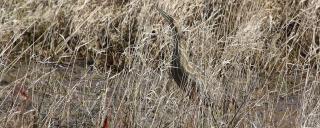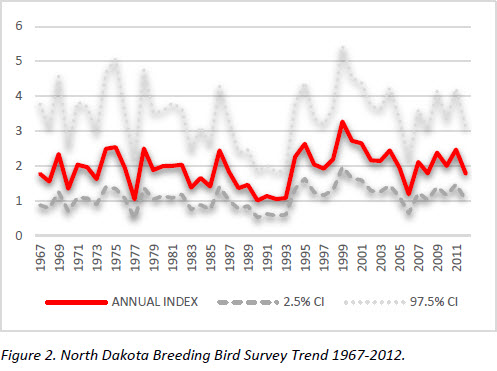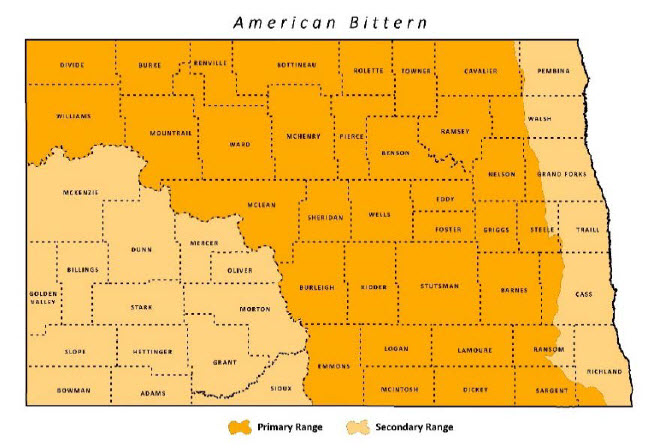
American Bittern
| Scientific Name | Botaurus lentiginosus |
|---|---|
| General Description | L 28”, WS 42”, 1.5 lb. Long, boldly striped neck with a pointed bill and greenish legs |
| Status | Occurs in North Dakota from mid-April to October. Peak breeding season mid-June to late July. |
| Abundance | Fairly common. |
| Primary Habitat | Uses a variety of wetlands, but typically larger wetlands with tall emergent vegetation. Also will nest in tall, dense grasslands. |
| Federal Status | Migratory Bird. |
| Reason for Designation | The American Bittern is listed as Critically Imperiled or Vulnerable in several states and provinces. Designated as High Concern in the Northern Prairie and Parkland Waterbird Conservation Plan (NPPWCP) and High Concern by Waterbird Conservation for the Americas. It is a USFWS Bird of Conservation Concern in BCR 11 and added to the 2008 BCC list in Region 6 and BCR17. |
Locations and Conditions of Key Habitat
Preferred Habitat
American Bitterns use a variety of freshwater wetlands including seasonal, semi-permanent, temporary, permanent, fens or restored wetlands. They tend to use wetlands which are > 3 ha in size with a large amount of tall, emergent vegetation present such as rushes, sedges, cattails, or common reed. Wetlands dominated by open water and alkali wetlands are generally avoided. Also are likely to occur in wetlands which are not isolated from other wetlands (i.e. prefer wetland complexes). Most commonly nest among dense emergent vegetation over shallow water, 5-20 cm deep. Bitterns will also nest in adjacent uplands of mid to tall (over 30 cm), dense, idle grasslands with moderate litter. The dominant grassland associated species include big bluestem, wheatgrass, smooth brome, switchgrass, and sweet clover. The bittern’s cryptic color helps it blend into surrounding habitat where it patiently waits for prey species of insects, amphibians, small fish, mammals, or crayfish to pass by.
Key Areas and Conditions for American Bitterns in North Dakota
No specific sites have been identified. Appear concentrated in central and southern portion of the Missouri Coteau. Also common in the Turtle Mountains, J. Clark Salyer NWR, and fairly common elsewhere east of the Missouri River in preferred habitat. The presence of this species may vary greatly from year to year dependent on water availability.
Problems Which May Affect this Species
Habitat
Wetland destruction and/or degradation and conversion of upland grassland for agricultural use negatively affect breeding populations. Habitat loss is believed the number one cause for decline of this species. Migration routes of American Bitterns using satellite telemetry data found that many birds (63%) breeding in the central part of North America wintered in the Everglades of Florida, an area impacted by a variety of threats.
Other Natural or Manmade Factors
Decline in the southern portion of the species range may be linked to declining amphibian populations. The bittern is at the top of the food chain, and its presence is a good indicator of environmental quality. Pesticides and contaminants pose a threat to wetland quality or primary prey species. Some mortality with communication towers.
Research and Survey Efforts
Current Research or Surveys
- Rocky Mountain Bird Observatory (ND SWG T-40-R) is conducting a statewide inventory of colonial and semi-colonial waterbird populations and identifying key sites for breeding colonies in North Dakota. The American Bittern is one of 29 target species. The project was initiated in March 2014 and a final report will be completed in December 2015.
Previous Research or Surveys
- Northern Prairie Wildlife Research Center (ND SWG T-3-1 and T- 9-R) determined marsh bird distribution in relation to landscape composition in North Dakota. The project was initiated in 2004 and a final report provided in 2008. American Bitterns were one of 16 focal species. American Bitterns were 8.2 times more likely to occur at wetlands in the Drift Prairie, and the probability that they would occur at a wetland were positively correlated with the percent of wetlands in the landscape (Sherfy and Anteau 2008).
Additional Research or Surveys Needed
Develop/refine surveys to determine present distribution, population estimates, and identify key areas.
- Demographic or life history information is lacking.
- Determine the effects of contaminants or insecticides on wetland quality and prey species.
Population and Trend Estimates

- Waterbird Conservation for the Americas Population Estimate: 2,976,000 individuals
- NPPWCP BCR11 Population Estimate: unknown
- North Dakota BBS Trend: see figure 2
- Survey-wide BBS Trend 1966-2012: -0.89
Management Recommendations
- Maintain wetland complexes of sufficient size (20 ha to 180 ha).
- Maintain water levels at less than 61 cm from April-August, avoid complete drawdowns before mid-August.
- Manage stock ponds for growth of emergent vegetation.
- Maintain a wide vegetative margin around wetlands.
- Disturbance to uplands (i.e. burning, mowing) should not occur more than every 2-5 years as bitterns prefer to nest in idle grasslands.
- Construction of communication towers should follow the guidance of “Service Interim Guidelines for Recommendations on Communications Tower Siting, Construction, Operation, and Decommissioning” and American Bird Conservancy Collision Program framework.
Monitoring Plans
The NPPWCP has identified the basic elements of how a regional/continental waterbird monitoring program should be structured. Waterbird monitoring should follow recommendations of the Waterbird Conservation for the Americas and North American Bird Conservation Initiative ‘Opportunities for Improving Avian Monitoring’.
2005-2015 Progress
The American Bittern remains a Level I Species of Conservation Priority. Efforts to identify key sites for breeding areas are underway. Several State Wildlife Grant Projects (T2-9-R, T-18-R, T-27-HM) have contributed to habitat enhancement of wetlands for American Bittern and other wetland dependent birds.

Note: A listing of works consulted when compiling the information on this page may be found in the 2015 State Wildlife Action Plan.
